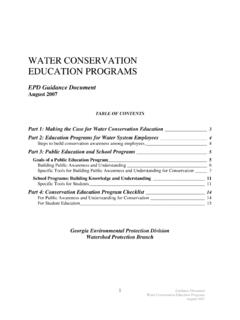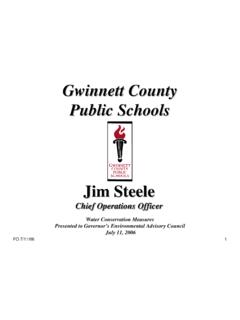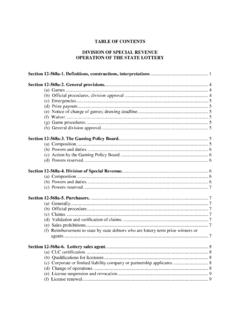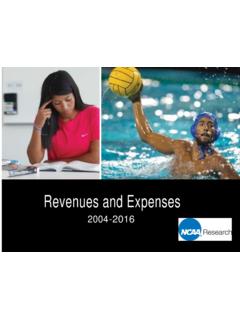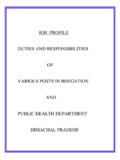Transcription of Meter Repair Replacement - Georgia Department of Natural ...
1 WATER Meter CALIBRATION, Repair , AND Replacement . PROGRAM. EPD Guidance Document AUGUST 2007. TABLE OF CONTENTS. Part 1: OVERVIEW OF WATER METERING _____ 3. SUMMARY _____ 3. NECESSITY OF meters _____ 3. TYPES OF WATER meters _____ 4. Meter USE AND APPLICATION _____ 5. Meter CALIBRATION AND Replacement PROGRAMS _____ 5. Part 2: CRITICAL ELEMENTS OF EPD WATER METERING PROGRAM ____ 6. Part 3: WATER METERING REPORTING AND TRACKING FORM_____ 8. Georgia Environmental Protection division Watershed Protection Branch 1. Guidance Document Meter Calibration, Repair and Replacement Program Developed by the Georgia Environmental Protection division (EPD). To support the Coastal Georgia Water and Wastewater Permitting Plan for Managing Saltwater Intrusion.
2 August 2007. This guidance document is intended for entities in the 24-county area of Georgia 's coast addressed in the Coastal Georgia Water and Wastewater Permitting Plan for Managing Saltwater Intrusion , located in Sub- Regions 1, 2 and 3, that are: Private Industrial Transient and Non-Transient Non-Community Water Systems (TNCWS and NTNCWS) with an Operating Permit and a Water Withdrawal Permit;. Private Industrial Transient and Non-Transient Non-Community Water Systems (TNCWS and NTNCWS) with ONLY an Operating Permit;. Privately Owned or Operated Public Community Drinking Water Systems with ONLY an Operating Permit;. Public Community Water Systems (CWS) with Water Withdrawal and/or Operating Permits.
3 Governmentally Owned or Operated Public Drinking Water Systems with an Operating Permit; or Governmentally Owned or Operated Transient Non-Community (TNCWS) or Non-Transient Non- Community Public Water Systems (NTNCWS) with either an Operating Permit and/or a Withdrawal Permit. It is designed to guide the development and implementation of a Meter calibration, Repair and Replacement program. When to use this guidance document: For most Upper Floridan aquifer groundwater use or withdrawal permittees in the coastal counties of Georgia , a special condition of all new or modified permits will be development and implementation of a water conservation education program.
4 Permittee must adopt a Meter calibration, Repair , and Replacement program and submit a copy of that program to the appropriate EPD. District Office (either Savannah or Brunswick) no later than 12 months from the permit issue date. The adopted metering program must include: (1) a schedule for installing meters for all water supply sources and service connections that are not currently metered; and, (2) annual calibration for meters for those users representing at least the top 10% of water users. This program must be updated at intervals determined by EPD. How to use this guidance document: This guide is organized into 3 parts: Part I: Overview of Program.
5 Provides a summary of the program, the applicability of the program, and the criteria to determine the implementation status of the program. Part II: Description of the Program Provides a detailed discussion of all aspects of the program and related compliance requirements. Part III: Forms Provides a form for reporting and tracking the implementation of the water-metering program. EPD Contact: If you have any questions, or require additional information, please contact the EPD. Drinking Water Program, at 404-656-2750. As the July 2006 Coastal Permitting Plan is implemented, EPD will welcome feedback from permittees regarding this guidance document. 2. Part 1: OVERVIEW OF WATER METERING.
6 SUMMARY. Water use metering is an essential element of efficiency and conservation management, and is necessary in order to conduct a system audit. Metering is a requirement for loss control, accounting and rate making, verification of water and cost savings, and the evaluation of the effectiveness of efficiency and conservation measures. Metering must be provided at all important water production processes and delivery locations including at the supply source, at critical in-plant control points, at wholesale delivery points, and at service connections. An effective metering program allows comparison of measured flows in the system and metered deliveries to customers, which can be used to identify leaks.
7 Water meters not only help utilities collect the revenue they are due, they also help pinpoint leaks, locate pressure problems along their waterways, and identify and study periods of peak and non-peak use among both residential and business consumers. But meters can only perform these feats if they are accurate. Unfortunately, water meters are not 100 percent accurate and can lose their sensitivity over time and fail to accurately monitor how much water businesses and residences are consuming. Inaccuracy in water use also results when the meters are outdated or in poor Repair . This is a serious problem and needs to be addressed, promptly. Inaccurate water meters not only result in lost income for often cash-strapped utilities, they also prevent utilities from realizing the potential for greater savings.
8 Without accurate meters , water and sewer departments cannot completely participate in some of the newest experiments and techniques designed to foster increased water efficiency. Accurate assessment of water usage is vital in keeping utility bills low and conserving water in drought conditions. In order to assure water is being accounted for accurately, meters need to be selected, installed, operated and maintained using generally accepted industry standards. meters should be regularly calibrated and tested in accordance with the manufacturer's recommendations or the guidelines recommended by the American Water Works Association (AWWA), Manual for Water meters -Selection, Installation, Testing, and Maintenance (AWWA M6).
9 NECESSITY OF meters . Source and service metering are key components to a successful water use efficiency program. Accounting for use and loss in a water distribution system is critical. Proper accounting will allow facilities to make informed decisions on operations, maintenance, capital investment, and customer service programs. Water metering provides information about how much water is used by whom, where, and in which season. This knowledge can be used to improve management of the water system and to fairly charge customers for the water they actually use. Lack of metering undermines loss control, costing and pricing, and other conservation measures.
10 The following topics should be carefully evaluated when developing a water - metering program: Source-water metering. Knowing the quantity of water supplied to a water distribution system is critical for all water systems. All possible water sources must be metered to account for volume supplied to a water distribution system. meters must be in convenient locations to allow for regular reading and calibration, and for other maintenance activities. If feasible, the volume of water supplied into the distribution system should be monitored on a continuous basis. This information will lead to a more comprehensive understanding of the water supplied to the system and will give useful information in determining the non-revenue water lost throughout the day.
